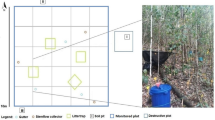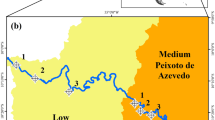Abstract
Litterfall from trees has been identified as an important pathway for deposition of mercury (Hg) and methylmercury (MeHg) in forested catchments, but very little is known about the role of ground vegetation in deposition and cycling of Hg compounds. This study was conducted to identify the origin of Hg compounds in the ground vegetation, and to estimate the role of its litterfall with respect to pools and fluxes of Hg in a coniferous forest in the German Fichtelgebirge mountains. Above and below ground biomass of the dominant ground vegetation (Vaccinium myrtillus, Deschampsia flexuosa and Calamagrostis villosa) were sampled at several plots successively during the growing season. The fluxes to the soil via litterfall of the ground vegetation were calculated using contents of Hg and MeHg in the annual fractions of aboveground biomass. With fluxes of 0.4 – 7.8 mg Hgtotal ha−1 a−1 and 0.01 – 0.04 mg MeHg ha−1 a−1 (depending on the plant species) this pathway contributes only a few percent to the total deposition of both compounds in the catchment. To identify the uptake pathways of Hg compounds, the same plant species were grown in a pot experiment with addition of isotope labelled Hg compounds (202Hg2+, Me198Hg) to a clean sand substrate. Only small proportions of 202Hg and Me198Hg in the substrate were taken up by the plants, but in all cases the proportion translocated into aboveground biomass after uptake was greater in case of Me198Hg. Thus, internal recycling in the plant-soil system is a source especially for MeHg in the ground vegetation. However, as compared to the input of Hg compounds by tree litterfall and storage in the forest floor, Hgtotal and MeHg in ground vegetation are of minor importance. High volatilization of added Hg isotopes raises the question of a re-emission of Hg compounds by the transpiration flux of the ground vegetation.
Similar content being viewed by others
References
Beauford W, Barber J and Barringer A R 1977 Uptake and distribution of mercury within higher plants. Physiol. Plant. 39, 261–265.
Bishop K H and Lee Y H 1997 Catchments as a source of mercury / methylmercury in boreal surface waters. In Metal Ions in Biological Systems, Vol. 34, Mercury and its Effects on Environment and Biology. Eds A Sigel and H Sigel. pp. 113–130. Deccer Inc., New York.
Bishop K H, Lee Y H, Munthe J and Dambrine E 1998 Xylem sap as a pathway for total mercury and methylmercury transport from soil to tree canopy in the boreal forest. Biogeochemistry 40, 101–113.
Browne C L and Fang C S 1978 Uptake of mercury vapor by wheat. An assimilation model. Plant Physiol. 61, 430–433.
Cappon C J 1987 Uptake and speciation of mercury and selenium in vegetable crops grown on compost-treated soil. Water Air Soil Pollut. 34, 353–361.
Cavallini A, Natali L, Durante M and Maserti B 1999 Mercury uptake, distribution and DNA affinity in durum wheat (Triticum durum Desf.) plants. Sci. Total Environ. 244, 119–127.
Falter R and Ilgen G 1997 Coupling of the RP C18 preconcentration HPLC-UV-PCO-system with atomic fluorescence detection for the determination of methylmercury in sediment and biological tissue. Fresenius J. Anal. Chem. 358, 407–410
Gaggi C, Chemello G and Bacci E 1991 Mercury-vapor accumulation in azalea leaves. Chemosphere 22, 869–872.
Gerstberger P 2001 Forest Ecosystem Research in Northern Bavaria. The Investigation Sites of the Bayreuth Institute for Terrestrial Ecosystem Research in the ‘Fichtelgebirge’ and the 'steigerwald'. [in German] Bayreuther Forum Ökologie 90. 193 pp.
Godbold D L and Hüttermann A 1988 Inhibition of photosynthesis and transpiration in relation to mercury-induced root damage in spruce seedlings. Physiol. Plant. 74, 270–275.
Hanson P J, Lindberg S E, Tabberer T A, Owens J G and Kim K H 1995 Foliar exchange of mercury vapor: Evidence for a compensation point. Wat. Air Soil Pollut. 80, 373–382.
Heeraman D A, Claassen V P and Zasoski R J 2001 Interaction of lime, organic matter and fertilizer on growth and uptake of arsenic and mercury by Zorro fescue (Vulpia myuros L.). Plant Soil 234, 215–231.
Hintelmann H 1999 Comparison of different extraction techniques used for methylmercury analysis with respect to accidental formation of methylmercury during sample preparation. Chemosphere 39, 1093–1105
Horvat M, Bloom N S and Liang L 1993 Comparison of distillation with other current isolation methods for the determination of methylmercury compounds in low level environmental samples Part II. Anal. Chim. Acta 282, 153–168
Köstner B 2001 Evaporation and transpiration from forests in Central Europe-Relevance of patch-level studies for spatial scaling. Meteorol. Atmos. Phys. 76, 69–82.
Landa E R 1978 Soil water content and temperature as factors in the volatile loss of applied mercury (II) from soils. Soil Sci. 126, 44–48.
Leonard T L, Taylor G E, Gustin M S and Fernandez G C J 1998 Mercury and plants in contaminated soils: 1. Uptake, partition and emission to the atmosphere. Environ. Toxicol. Chem. 17, 2063–2071.
Lindberg S E and Meyers T P 2001 Development of an automated micrometeorological method for measuring the emission of mercury vapor from wetland vegetation. Wetlands Ecol. Manage. 9, 333–347.
Lindberg S E, Hanson P J, Meyers T P and Kim K H 1998 Air/surface exchange of mercury vapor over forests-the need for a reassessment of continental biogenic emissions. Atmos. Environ. 32, 895–908.
Mosbaek H, Tjell J C and Sevel T 1988 Plant uptake of airborne mercury in background areas. Chemosphere 17, 1227–1236.
Munthe J, Hultberg H and Iverfeldt Å 1995 Mechanisms of deposition of methylmercury and mercury to coniferous forests. Wat. Air Soil Pollut. 80, 363–371.
Nitschke F R 2001 Konzeptionelle Entwicklung von Mikrokosmos-Experimenten zur Untersuchung der speziesspezifischen Transformationsprozesse des Quecksilbers mittels Isotopenverhältnisbestimmungen [in German]. PhD Thesis University of Mainz, Germany, 139 p.
Nuorteva P, Autio S, Lehtonen J, Lepistö A, Ojala S, Seppänen A, Tulisalo E, Veide P, Viipuri J and Willamo R 1986 Levels of iron, aluminium, zinc, cadmium and mercury in plants growing in the surrounding of an acidified and non acidified lake in Espoo, Finland. Ann. Bot. Fenn. 23, 333–340.
Patra M and Sharma A 2000 Mercury toxicity in plants. Bot. Rev. 66, 379–422.
Rea A W, Lindberg S E and Keeler G J 2001 Dry deposition and foliar leaching of mercury and selected trace elements in deciduous forest throughfall. Atmos. Environ. 35, 3453–3462.
Rea A W, Lindberg S E, Scherbatskoy T and Keeler G J 2002 Mercury accumulation in foliage over time in two northern mixed-hardwood forests. Wat. Air Soil Pollut. 133, 49–67.
Särkelä M and Nuorteva P 1987 Levels of aluminium, iron, zinc, cadmium, and mercury in some indicator plants growing in unpolluted Finnish Lapland. Ann. Bot. Fenn. 24, 301–305.
Schwesig D and Matzner E 2000 Pools and fluxes of mercury and methylmercury in two forested catchments in Germany. Sci. Total Environ. 260, 213–223
Schwesig D and Matzner E 2001 Dynamics of mercury and methylmercury in forest floor and runoff of a forested watershed in Central Europe. Biogeochemistry 53, 181–200.
Shanker K, Mishra S, Srivastava S, Srivastava R, Daas S, Prakash S and Srivastava M M 1996a Effect of selenite and selenate on plant uptake and translocation of mercury by tomato (Lycopersicum esculentum). Plant Soil 183, 233–238.
Shanker K, Mishra S, Srivastava S, Srivastava R, Daas S, Prakash S and Srivastava M M 1996b Study of mercury-selenium (Hg-Se) interactions and their impact on Hg uptake by the radish (Raphanus sativus) plant. Food Chem. Toxicol. 34, 883–886.
Suszcynsky E M and Shann J R 1995 Phytotoxicity and Accumulation of Mercury in Tabacco Subjected to Different Exposure Routes. Environ. Toxicol. Chem. 14, 61–67.
Väisänen S 1986 Effects of air pollution by metal, chemical and fertilizer plants on forest vegetation at Kokkola, W Finland. Ann. Bot. Fenn. 23, 305–315.
Author information
Authors and Affiliations
Corresponding author
Rights and permissions
About this article
Cite this article
Schwesig, D., Krebs, O. The role of ground vegetation in the uptake of mercury and methylmercury in a forest ecosystem. Plant and Soil 253, 445–455 (2003). https://doi.org/10.1023/A:1024891014028
Issue Date:
DOI: https://doi.org/10.1023/A:1024891014028




